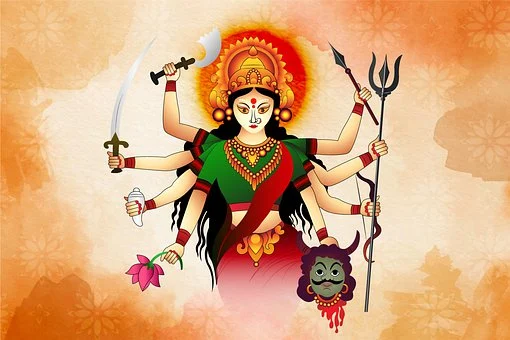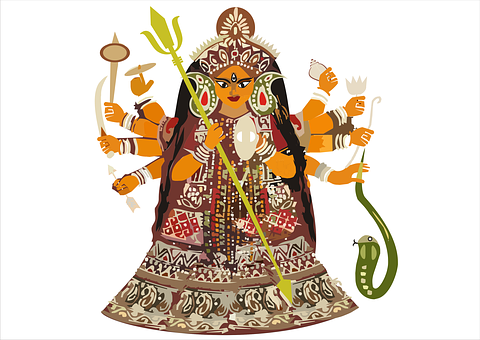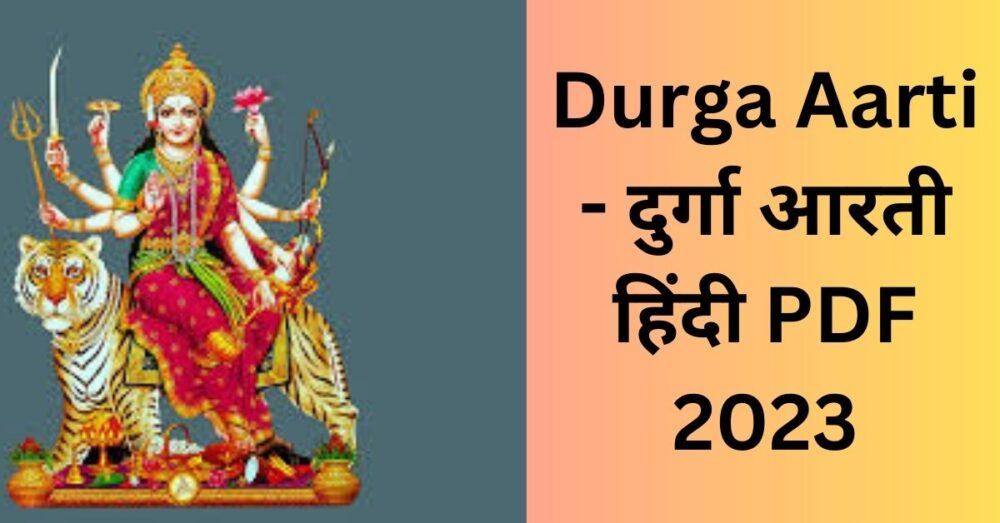Durga Aarti is a Hindu ritual that involves the worship of the goddess Durga, the embodiment of feminine power and strength. This practice is observed by millions of devotees worldwide, particularly during the festival of Navratri, which celebrates the victory of good over evil.
The Aarti ceremony involves the offering of prayers and hymns to the goddess, accompanied by the lighting of lamps and the waving of incense. This act of devotion is said to invoke the blessings of Durga, bestowing her devotees with courage, prosperity, and protection from harm.
Beyond its spiritual significance, Durga Aarti holds cultural and historical importance as well, with its origins dating back to ancient times. In this blog post, we will explore the symbolism and meaning behind Durga Aarti, its historical and cultural significance, popular hymns and mantras, as well as its modern relevance and impact on society.

Contents
- 1 Historical and cultural significance of Durga Aarti
- 2 Shri Durga Aarti In Hindi
- 3 Rituals and practices during Durga Aarti
- 4 Symbolism and meaning behind Durga Aarti
- 5 Popular Durga Aarti hymns and mantras
- 6 Benefits and blessings of performing Durga Aarti
- 7 Durga Aarti in different regions of India
- 8 Modern relevance and impact of Durga Aarti
- 9 FAQs
- 9.1 What is Durga Aarti?
- 9.2 What is the significance of Durga Aarti?
- 9.3 What are the hymns and mantras used in Durga Aarti?
- 9.4 When is Durga Aarti performed?
- 9.5 How is Durga Aarti performed?
- 9.6 What are the benefits of performing Durga Aarti?
- 9.7 Can anyone perform Durga Aarti?
- 9.8 Is Durga Aarti only practiced in India?
- 9.9 How does Durga Aarti promote environmental consciousness?
- 9.10 Can non-Hindus participate in Durga Aarti?
- 10 Conclusion
Historical and cultural significance of Durga Aarti
The Durga Aarti has a rich historical and cultural significance that dates back to ancient times. In Hindu mythology, Durga is considered to be a powerful goddess who represents the divine feminine energy or Shakti. According to legend, Durga was created by the gods to defeat the demon Mahishasura, who had obtained invincibility from Lord Brahma through a boon.
The battle between Durga and Mahishasura lasted for nine days and nine nights, and on the tenth day, Durga emerged victorious. This is why the festival of Navratri is celebrated for nine days, with the tenth day being known as Vijayadashami or Dussehra, which marks the victory of good over evil.
The Durga Aarti is an essential part of the Navratri celebrations, and it is believed to be a way to honor the goddess and seek her blessings. The ritual involves the offering of light to the goddess, which represents her divine energy and power. The hymns and mantras that are chanted during the aarti express gratitude and devotion towards the goddess, while also seeking her guidance and protection.
The Durga Aarti also has cultural significance, as it is a way to pass on the tradition of worship and devotion from one generation to another. It is a way for families and communities to come together and celebrate the festival of Navratri, while also strengthening their bonds and connections.
Furthermore, the Durga Aarti is not just limited to India, but it is also performed by Hindus across the world, who share a common belief and devotion towards the goddess Durga. This highlights the universal appeal and significance of the Durga Aarti, which transcends boundaries and brings people together in a shared expression of faith and devotion.
Shri Durga Aarti In Hindi

ॐ जय अम्बे गौरी, मैया जय श्यामा गौरी ।
तुमको निशिदिन ध्यावत हरि ब्रह्मा शिवरी ॥जय॥
मांग सिंदूर बिराजत टीको मृगमद को ।
उज्ज्वल से दोउ नैना चंद्रबदन नीको ॥जय॥
कनक समान कलेवर रक्ताम्बर राजै।
रक्तपुष्प गल माला कंठन पर साजै ॥जय॥
केहरि वाहन राजत खड्ग खप्परधारी ।
सुर-नर-मुनिजन सेवत तिनके दुःखहारी ॥जय॥
कानन कुण्डल शोभित नासाग्रे मोती ।
कोटिक चंद्र दिवाकर राजत समज्योति ॥जय॥
शुम्भ निशुम्भ बिडारे महिषासुर घाती ।
धूम्र विलोचन नैना निशिदिन मदमाती ॥जय॥
चण्ड-मुण्ड संहारे, शोणित बीज हरे।
मधु-कैटभ दोउ मारे, सुर भयहीन करे॥जय॥
ब्रहमाणी रुद्राणी तुम कमला रानी।
आगम-निगम-बखानी, तुम शिव पटरानी॥जय॥
चौंसठ योगिनि मंगल गावैं नृत्य करत भैरू।
बाजत ताल मृदंगा अरू बाजत डमरू ॥जय॥
तुम ही जग की माता, तुम ही हो भरता।
भक्तन की दु:ख हरता, सुख सम्पत्ति करता॥जय॥
भुजा चार अति शोभित खड्ग खप्परधारी।
मनवांछित फल पावत सेवत नर नारी ॥जय॥
कंचन थाल विराजत अगर कपूर बाती ।
श्री मालकेतु में राजत कोटि रतन ज्योति ॥जय॥
श्री अम्बेजी की आरती जो कोई नर गावै ।
कहत शिवानंद स्वामी सुख-सम्पत्ति पावै ॥जय॥
Rituals and practices during Durga Aarti
During the Durga Aarti, there are several rituals and practices that are followed to offer worship and devotion to the goddess Durga.
- Preparation: Before the aarti, the devotees take a bath and wear clean clothes. They also decorate the area with flowers, rangoli, and other decorative items.
- Lighting the Lamp: The aarti begins by lighting a lamp or diya, which represents the divine energy of the goddess.
- Chanting of Mantras: The devotees chant various mantras and hymns during the aarti, which express their devotion and gratitude towards the goddess Durga. The most popular mantra that is chanted during the aarti is “Om Jai Ambe Gauri.”
- Offering of Flowers and Incense: The devotees offer flowers, incense, and other items to the goddess Durga, which are considered to be auspicious and pleasing to her.
- Ringing of Bells: The ringing of bells is an essential part of the aarti, which is believed to ward off negative energy and bring positive vibrations to the surroundings.
- Aarti : The aarti is performed by the devotees, who move the lamp or diya in a circular motion in front of the goddess. This represents the offering of light to the goddess, which is considered to be a way to seek her blessings and protection.
- Distribution of Prasad: After the aarti is completed, the prasad is distributed among the devotees, which is considered to be blessed by the goddess Durga.
Symbolism and meaning behind Durga Aarti

The Durga Aarti is rich in symbolism and meaning, reflecting the significance of the goddess Durga and her role in Hindu mythology. Here are some of the key symbols and their meanings:
- The Lamp: The lamp or diya that is lit during the aarti represents the divine energy of the goddess, which illuminates the darkness and brings hope and positivity to the surroundings.
- Flowers: The flowers that are offered to the goddess represent beauty, purity, and devotion. They are believed to be a way to please the goddess and seek her blessings.
- Incense: The incense that is offered during the aarti symbolizes the purification of the surroundings, as well as the offering of fragrance to the goddess.
- Bells: The bells that are rung during the aarti are believed to ward off negative energy and bring positive vibrations to the surroundings. They also represent the music of the cosmos and the harmony of the universe.
- Mantras: The mantras and hymns that are chanted during the aarti represent the devotion and gratitude of the devotees towards the goddess Durga. They are also believed to have a powerful spiritual impact on the surroundings.
- Aarti : The circular motion of the lamp or diya during the aarti represents the offering of light to the goddess, which is considered to be a way to seek her blessings and protection.
Popular Durga Aarti hymns and mantras
The Durga Aarti is accompanied by several hymns and mantras that are chanted by the devotees during the ritual. These hymns and mantras hold great significance and are believed to invoke the blessings of the goddess Durga. Some of the popular Durga Aarti hymns and mantras include:
- “Jai Ambe Gauri”: This is a popular hymn dedicated to the goddess Durga, which is chanted during the aarti. It praises the goddess and seeks her blessings for protection, strength, and prosperity.
- “Om Jai Jagdish Hare”: This is a widely known and revered hymn in Hindu culture that is often recited during various religious rituals, including the Durga Aarti. It is a prayer to Lord Vishnu, seeking his blessings for peace, happiness, and well-being.
- “Ya Devi Sarva Bhuteshu”: This mantra is taken from the famous Durga Saptashati, a revered text that praises the glory of the goddess Durga. It is chanted during the aarti to invoke the blessings of the goddess and seek her protection from all evils.
- “Sarva Mangala Mangalye”: This mantra is a powerful invocation of the goddess Durga, which is chanted during the aarti to seek her blessings for all-round well-being, prosperity, and protection from all obstacles.
- “Durga Chalisa”: This is a devotional hymn dedicated to the goddess Durga, composed of 40 verses that highlight the greatness and virtues of the goddess. It is chanted during the aarti as an expression of devotion and gratitude towards the goddess.
Benefits and blessings of performing Durga Aarti
Performing Durga Aarti is believed to offer several benefits and blessings to the devotees. Some of the significant benefits and blessings of performing Durga Aarti are:
- Divine blessings: The ritual of Durga Aarti is considered as a way of seeking the blessings of the goddess Durga. By performing the aarti, devotees seek protection, good health, prosperity, and overall well-being.
- Spiritual upliftment: The sacred hymns and mantras recited during the aarti create a spiritual ambiance and uplift the devotee’s soul. It helps to develop a deeper connection with the divine and cultivate a sense of inner peace and harmony.
- Removal of negative energies: The aarti is believed to have the power to dispel negative energies and bring positivity and light into the devotee’s life. It is believed to help eliminate negative emotions like anger, jealousy, and hatred.
- Strengthening of faith: Performing the Durga Aarti is an act of devotion and surrender to the divine. It helps to strengthen the devotee’s faith in the goddess and cultivates a sense of gratitude towards the divine.
- Protection from evil: The goddess Durga is known for her power to destroy evil and protect her devotees from all harm. By performing the Durga Aarti, devotees seek the protection of the goddess from all kinds of obstacles and negative influences.
Durga Aarti in different regions of India
Durga Aarti is a popular ritual in various regions of India and is celebrated with great enthusiasm and devotion. While the aarti remains the same, the way it is performed and the hymns used may differ slightly in different regions. Here are some of the regional variations of Durga Aarti in India:
- Bengali Durga Aarti: In Bengal, Durga Aarti is known as ‘Durga Puja Aarti.’ It is performed with a dhunuchi, a traditional earthen pot filled with burning coconut husk and camphor. The hymns sung during the aarti are in Bengali and are typically devotional songs dedicated to the goddess.
- North Indian Durga Aarti: In North India, the Durga Aarti is performed using a brass lamp with several wicks. The hymns sung during the aarti are usually in Hindi and include popular devotional songs like ‘Jai Ambe Gauri’ and ‘Om Jai Jagdish Hare.’
- Maharashtra Durga Aarti: In Maharashtra, Durga Aarti is known as ‘Mahalakshmi Aarti.’ It is performed using a brass lamp with multiple wicks, and the hymns sung during the aarti are in Marathi. The aarti is often accompanied by the sound of dhol and tasha, traditional Indian percussion instruments.
- South Indian Durga Aarti: In South India, the Durga Aarti is performed using a brass lamp with multiple wicks, and the hymns sung during the aarti are in Sanskrit. The aarti is often accompanied by the sound of traditional South Indian instruments like the mridangam and ghatam.
- Gujarati Durga Aarti: In Gujarat, Durga Aarti is known as ‘Ambe Maa Aarti.’ It is performed using a brass lamp with multiple wicks, and the hymns sung during the aarti are in Gujarati. The aarti is often accompanied by the sound of traditional Gujarati instruments like the dhol and shehnai.
Modern relevance and impact of Durga Aarti
Durga Aarti, like many other traditional rituals and practices, continues to hold great relevance and impact in modern times. Here are some of the ways in which Durga Aarti remains relevant today:
- Spiritual Connection: Durga Aarti offers a way for devotees to connect with their spiritual beliefs and express their devotion to the goddess. The ritual helps to create a sense of unity and community among those who participate, regardless of their backgrounds or beliefs.
- Emotional Healing: The practice of performing Durga Aarti can be a source of emotional healing and comfort for those who are going through a difficult time. The hymns and mantras used during the aarti can help to soothe the mind and bring a sense of calm and peace.
- Cultural Identity: Durga Aarti is an important aspect of Indian culture and heritage, and the ritual helps to preserve and promote this cultural identity. The aarti is an opportunity for people to connect with their roots and celebrate the rich traditions of their ancestors.
- Social Impact: Many Durga Aarti celebrations involve charitable activities such as donating food, clothes, or money to those in need. This social impact helps to make a positive difference in the lives of others and contributes to the overall well-being of society.
- Environmental Consciousness: In recent times, many Durga Aarti celebrations have become more environmentally conscious by using eco-friendly materials and reducing waste. This awareness helps to promote sustainable living and protect the environment.
Download More – Om Jai Jagdish Hare Aarti
FAQs
What is Durga Aarti?
Durga Aarti is a sacred Hindu ritual that involves the offering of light and prayers to the goddess Durga.
What is the significance of Durga Aarti?
Durga Aarti has historical, cultural, and spiritual significance. It is believed to invoke the blessings of the goddess Durga and bring good fortune to those who perform it.
What are the hymns and mantras used in Durga Aarti?
The hymns and mantras used in Durga Aarti vary based on regional and cultural traditions. Some popular ones include the “Om Jai Ambe Gauri” and “Jai Durga Mata” hymns.
When is Durga Aarti performed?
Durga Aarti is typically performed during Navratri, a nine-day festival celebrating the victory of good over evil. It is also performed on other auspicious occasions such as weddings and housewarming ceremonies.
How is Durga Aarti performed?
Durga Aarti involves the offering of light, flowers, and prayers to the goddess Durga while singing hymns and reciting mantras. It is typically performed in front of a sacred image or statue of the goddess.
What are the benefits of performing Durga Aarti?
Performing Durga Aarti is believed to invoke the blessings of the goddess Durga and bring good fortune, health, and prosperity to those who perform it. It is also believed to offer spiritual benefits such as emotional healing and comfort.
Can anyone perform Durga Aarti?
Yes, anyone can perform Durga Aarti as long as they have a sincere devotion to the goddess and follow the appropriate rituals and practices.
Is Durga Aarti only practiced in India?
No, Durga Aarti is also practiced in other countries where there is a significant Hindu population, such as Nepal, Bangladesh, and Indonesia.
How does Durga Aarti promote environmental consciousness?
Durga Aarti involves the use of natural materials such as flowers and oil lamps, which promotes the use of sustainable and eco-friendly resources. It also encourages individuals to be mindful of their impact on the environment.
Can non-Hindus participate in Durga Aarti?
Yes, non-Hindus are welcome to participate in Durga Aarti as long as they respect the traditions and practices of the ritual and approach it with a sincere and open-minded attitude.
Conclusion
Durga Aarti is a sacred ritual that has been an integral part of Indian culture and heritage for centuries. It is a time-honored tradition that brings people together in devotion and celebration of the goddess Durga. The hymns and mantras used during the aarti carry deep symbolism and meaning, and the ritual itself has historical and cultural significance.
Beyond its traditional roots, Durga Aarti remains relevant and impactful in modern times. It offers a way for people to connect with their spiritual beliefs, find emotional healing and comfort, and celebrate their cultural identity. Additionally, it has a social impact by promoting charitable activities and environmental consciousness.
As we continue to navigate the complexities of modern life, the practice of Durga Aarti serves as a reminder of the enduring power of traditional rituals and practices to bring people together and promote well-being.
Durga Aarti – दुर्गा आरती हिंदी PDF 2023
Read More – Durga Aarti
